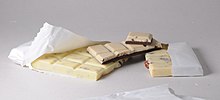Different forms and flavors of chocolate are produced by varying the quantities of the different ingredients. Other flavors can be obtained by varying the time and temperature when roasting the beans.
- "Unsweetened chocolate", also known as "bitter", "baking chocolate", or "cooking chocolate", is pure chocolate liquor mixed with some form of fat to produce a solid substance. The pure, ground, roasted cocoa beans impart a strong, deep chocolate flavor. With the addition of sugar, however, it is used as the base for cakes, brownies, confections, and cookies.
-
"Dark chocolate", also called "black chocolate", is produced by adding fat and sugar to cocoa. It is chocolate with no milk or much less than milk chocolate. The U.S. has no official definition for dark chocolate. Dark chocolate can be eaten as is, or used in cooking, for which thicker, baking bars, usually with high cocoa percentages ranging from 70% to 99% are sold. Dark is synonymous with semisweet, and extra dark with bittersweet, although the ratio of cocoa butter to solids may vary.
- "Semisweet chocolate" is frequently used for cooking purposes. It is a dark chocolate with (by definition in Swiss usage) half as much sugar as cocoa, beyond which it is "sweet chocolate."
- "Bittersweet chocolate" is chocolate liquor (or unsweetened chocolate) to which some sugar (less than a third), more cocoa butter, vanilla, and sometimes lecithin has been added. It has less sugar and more liquor than semisweet chocolate, but the two are interchangeable when baking. Bittersweet and semisweet chocolates are sometimes referred to as 'couverture'. Many brands now print on the package the percentage of cocoa in the chocolate (as chocolate liquor and added cocoa butter). The higher the percentage of cocoa, the less sweet the chocolate is.
- "Couverture" is a term used for chocolates rich in cocoa butter. Popular brands of couverture used by professional pastry chefs and often sold in gourmet and specialty food stores include: Valrhona, Felchlin, Lindt & Sprüngli, Scharffen Berger, Cacao Barry, Callebaut, Chocodate, Chocofig fuel chocolates, and Guittard. These chocolates contain a high percentage of cocoa.
- "Milk chocolate" is solid chocolate made with milk in the form of milk powder, liquid milk, or condensed milk added. In the 1870s, Swiss confectioner Daniel Peter developed solid milk chocolate using condensed milk, but German company Jordan & Timaeus in Dresden, Saxony had already invented milk chocolate in 1839;[2] hitherto it had only been available as a drink.[3] The U.S. Government requires a 10% concentration of chocolate liquor. EU regulations specify a minimum of 25% cocoa solids. However, an agreement was reached in 2000 that allowed what by exception from these regulations is called "milk chocolate" in the UK, Ireland, and Malta, containing only 20% cocoa solids, to be traded as "family milk chocolate" elsewhere in the European Union.[4]
- "Hershey process" milk chocolate is popular in North America. It was invented by Milton S. Hershey, founder of The Hershey Company, and can be produced more cheaply than other processes since it is less sensitive to the freshness of the milk. The process is a trade secret, but experts speculate that the milk is partially lipolyzed, producing butyric acid, which stabilizes the milk from further fermentation. This compound gives the product a particular sour, "tangy" taste, to which the American public has become accustomed, to the point that other manufacturers now simply add butyric acid to their milk chocolates.[3]
- "White chocolate" is a confection based on sugar, milk, and cocoa butter without the cocoa solids.
- "Cocoa powder" is used for baking, and for drinking with added milk and sugar. There are two types of unsweetened cocoa powder: natural cocoa (like the sort produced by the Broma process), and Dutch-process cocoa. Both are made by pulverising partially defatted chocolate liquor and removing nearly all the cocoa butter; Dutch-process cocoa is additionally processed with alkali to neutralise its natural acidity. Natural cocoa is light in colour and somewhat acidic with a strong chocolate flavour. Natural cocoa is commonly used in recipes that also use baking soda; as baking soda is an alkali, combining it with natural cocoa creates a leavening action that allows the batter to rise during baking. Dutch cocoa is slightly milder in taste, with a deeper and warmer colour than natural cocoa. Dutch-process cocoa is frequently used for chocolate drinks such as hot chocolate due to its ease in blending with liquids. However, Dutch processing destroys most of the flavonoids present in cocoa.[5] In 2005 Hershey discontinued their pure Dutch-process European Style cocoa and replaced it with Special Dark, a blend of natural and Dutch-process cocoa.
- "Compound chocolate" is the technical term for a confection combining cocoa with vegetable fat, usually tropical fats and/or hydrogenated fats, as a replacement for cocoa butter. It is often used for candy bar coatings. In many countries it may not legally be called "chocolate".
- "Raw chocolate" is chocolate that has not been processed, heated, or mixed with other ingredients. It is sold in chocolate-growing countries, and to a much lesser extent in other countries, often promoted as healthy.[6]
Flavors such as mint, vanilla, coffee, orange, or strawberry are sometimes added to chocolate in a creamy form or in very small pieces. Chocolate bars frequently contain added ingredients such as peanuts, nuts, fruit, caramel, and crisped rice. Pieces of chocolate, in various flavours, are sometimes added to cereals and ice cream.
| < Prev | Next > |
|---|



















